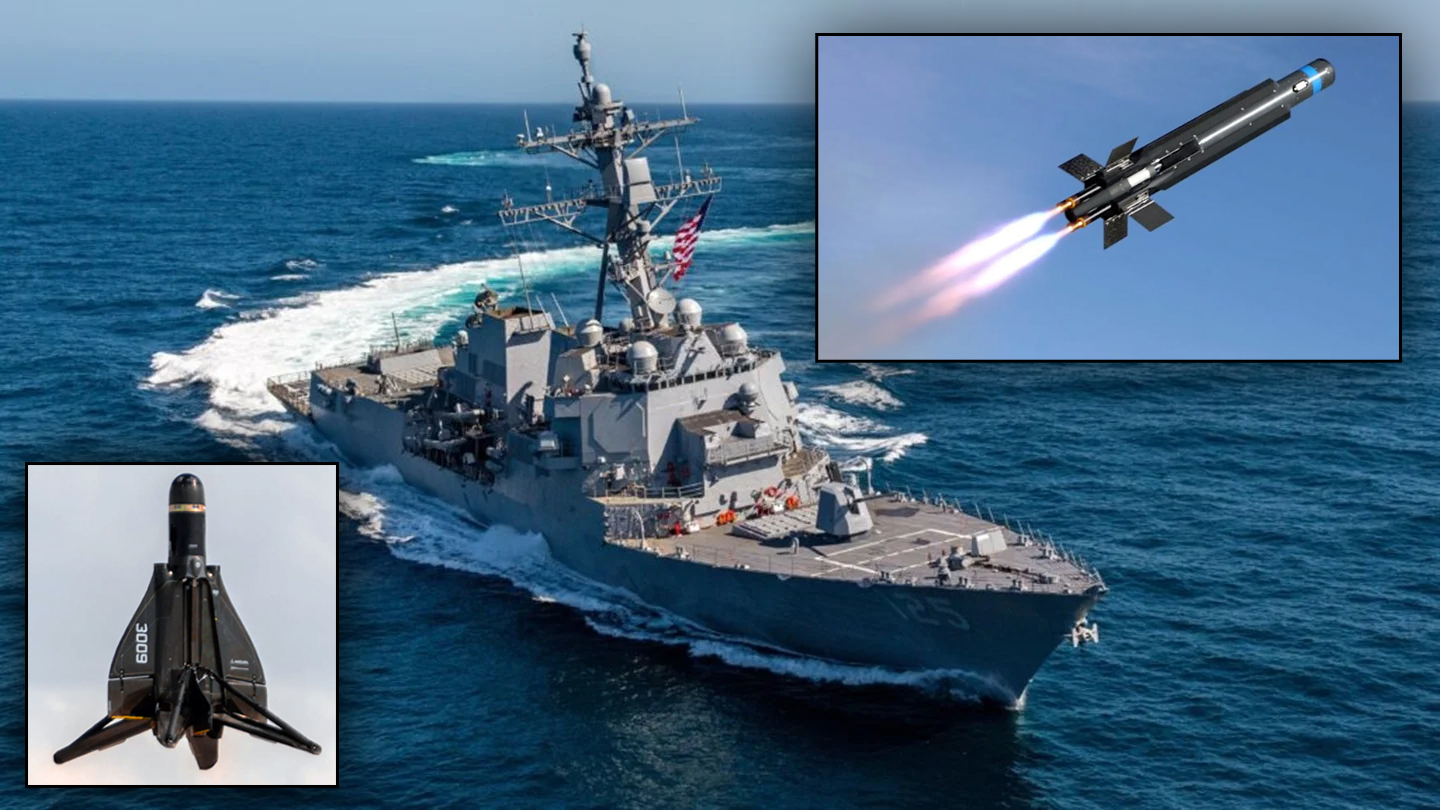When the U.S. Navy’s supercarrier USS Gerald R. Ford deploys later this year, its strike group will include Arleigh Burke class destroyers armed with Raytheon Coyote and Anduril Roadrunner-M counter-drone loitering interceptors. Last year, TWZ laid out a detailed case for arming American warships with swarms of drones to provide a valuable additional layer of defense, as well as enhance their strike, intelligence-gathering, and networking capabilities. You can read that in-depth exclusive feature here.
Military.com was the first to report on the planned integration of the combat-proven Coyote and the Roadrunner-M, which the U.S. military is buying steadily more of, onto Navy Arleigh Burke class destroyers. This has come in response, at least in part, to lessons learned from U.S. operations against Iranian-backed Houthi militants in and around the Red Sea. Since October 2023, the Houthis have been launching long-range kamikaze drones, as well as cruise and ballistic missiles, at foreign warships and commercial vessels, as well as targets in Israel.
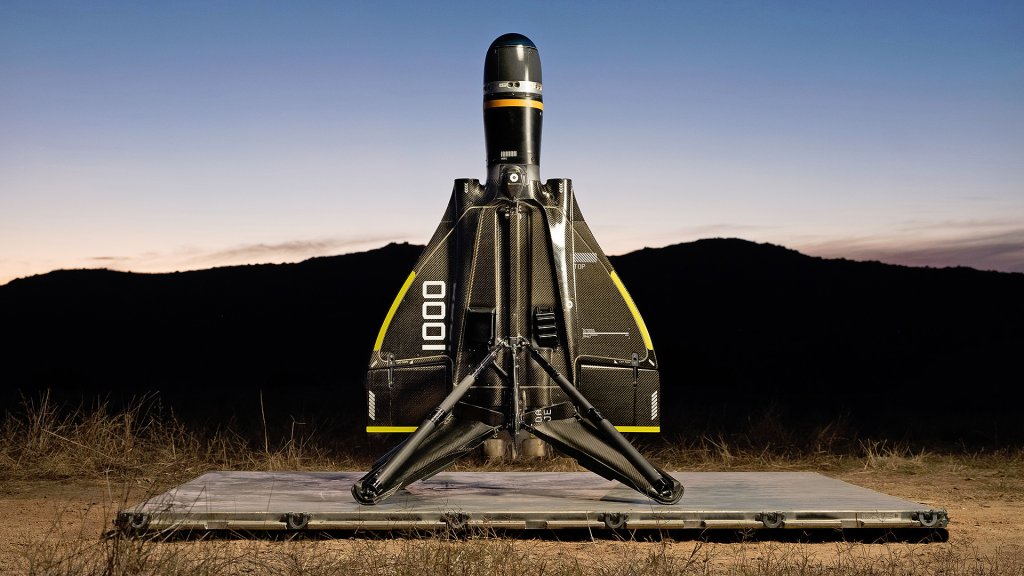
“We’re going to be deploying the Ford Strike Group with two additional missile systems on our destroyers – the Roadrunner system and the Coyote system – both specifically designed to go after UAVs [uncrewed aerial vehicles],” Navy Adm. Daryl Caudle, head of U.S. Fleet Forces Command, told reporters last week, according to Military.com.
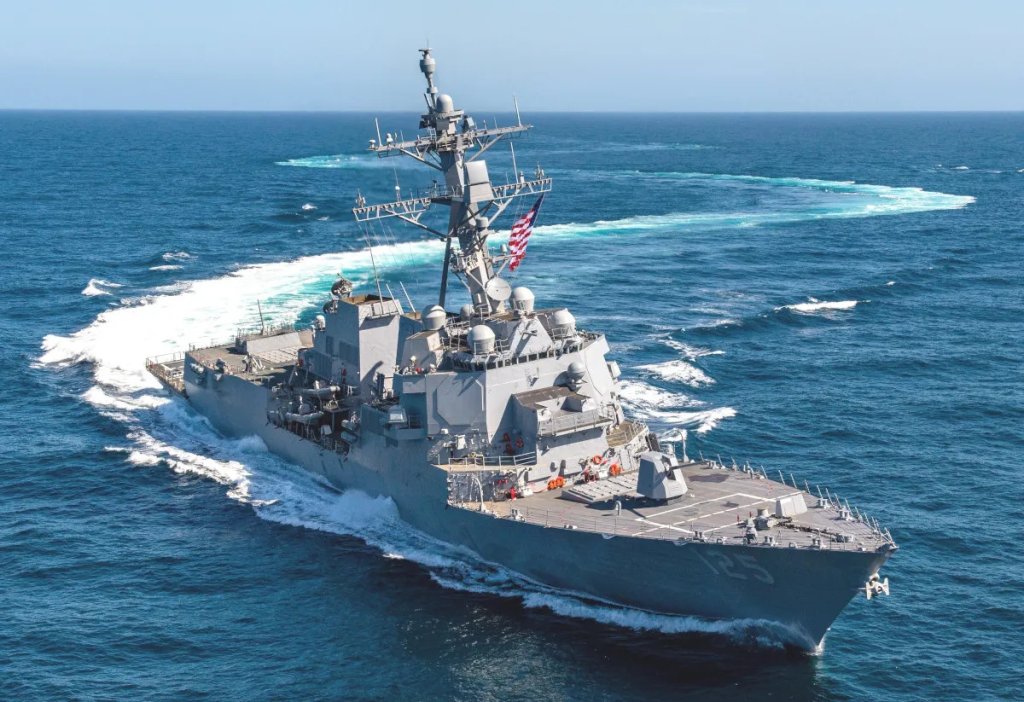
The counter-drone version of Coyote, also known as the Coyote Block 2, and the Roadrunner-M are both jet-powered drone-like loitering interceptors. Roadrunner-M has the additional ability to return to its point of launch to be refueled and reused if it is not expended in the course of a mission. When it comes to both Coyote and Roadrunner-M, a mixture of sensors are used to cue them to their targets, or at least the general target area, before their onboard seekers kick in.


The U.S. Army currently fields Coyote Block 2 as part of the mobile and fixed-site versions of its Low, Slow, Unmanned Aircraft Integrated Defeat System (LIDS). Versions of LIDS have been deployed to sites in the Middle East, Africa, and Europe and have seen combat use in at least some of those locales. The U.S. special operations community is known to have fielded Roadrunner-M in a land-based configuration, though details of its use to date are limited.
What exactly the integration of counter-drone systems using Coyote or Roadrunner-M onto the Arleigh Burke will consist of, including whether or not they will be tied in with the Aegis Combat Systems on those ships, is unclear. When reached for more information, a spokesperson for Raytheon (now formally RTX) directed TWZ to contact Naval Sea Systems Command (NAVSEA). TWZ has also reached out to NAVSEA and Anduril for more details.
The Navy currently has a total of 74 Arleigh Burke class destroyers in service, a fleet that includes multiple subvariants. They are all equipped with Mk 41 Vertical Launch System (VLS) arrays (though with differing numbers of total launch cells) that can fire various kinds of missiles, including Standard-series and Evolved Sea Sparrow Missile (ESSM) surface-to-air types, as well as Tomahawk land-attack cruise missiles. Some versions also have additional launchers for Harpoon or Naval Strike Missile (NSM) anti-ship cruise missiles.
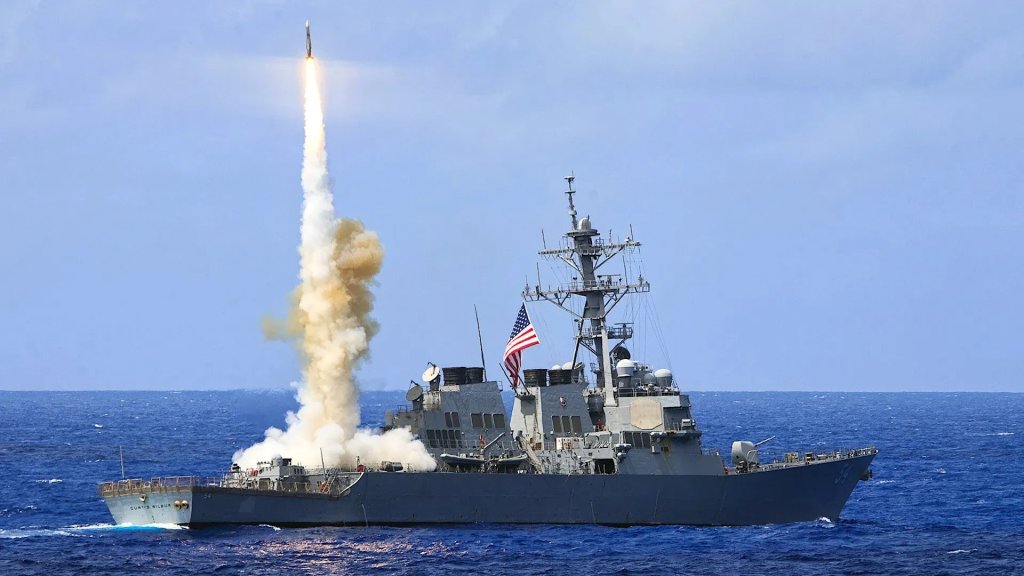
Depending on the particular subvariant, the Arleigh Burkes also have either launchers for RIM-116 Rolling Airframe Missiles (RAM) or 20mm Vulcan cannon-armed Mk 15 Phalanx Close-in Weapon Systems (CIWS) for close-in defense against aerial threats, including drones. Those in the ‘Rota’ configuration have both. The Navy is now moving to replace the Phalanxes on all of its destroyers with RAM launchers.
The Arleigh Burkes also have a 5-inch main gun in a turret on the bow, which can be used to engage aerial targets, along with ones at sea and on land, as you can read more about here.
Coyote and Roadrunner “are part of that attempt to get after the cost curve, give our commanding officers more options to engage the threat and ultimately be more effective in defending the high-value unit,” Navy Capt. Mark Lawrence, commander of Destroyer Squadron Two (DESRON 2), also told reporters earlier this month per Military.com.
In January, the Navy said its warships operating in and around the Red Sea had fired 120 Standard Missile-2s (SM-2), 80 SM-6s, a combined total of 20 ESSMs and SM-3s, as well as 160 5-inch rounds against aerial threats launched by the Houthis (and likely by Iran), over the preceding 15 months. SM-2s each cost around $2.5 million, while more capable SM-6s have price tags of around $4.27 million. The price for each ESSM is around $1.5 million. SM-3 variants, which are higher-end interceptors capable of knocking ballistic missiles during the midcourse portion of their flight, cost between $12.5 million and $28.7 million depending on variant. The RIM-116s that Arleigh Burke class destroyers are also armed with run just under $1 million apiece. You can read more about these missiles and their costs here.

For comparison, the cost of a single Block 2 Coyote is reportedly around $100,000. Anduril has previously said that Roadrunner-M’s unit cost is in the low hundreds of thousands of dollars.
In addition to offering a valuable lower-cost-per-intercept option, especially against long-range kamikaze drones that might cost as little as $50,000, arming Arleigh Burkes with Coyote and/or Roadrunner-M will also give the destroyers valuable additional magazine depth. As TWZ wrote in the feature about adding various types of drones to the arsenal of American warships last year:
“When used in large numbers, these drones, cooperatively swarming or not, can deplete a ship’s defensive arsenal, attacking from multiple vectors. Close-in weapon systems can quickly run out of ammunition and need reloading, leaving the ship’s inner point defense layer degraded and thus making the vessel more vulnerable. Even American and allied warships facing off against the Houthi drones have had to use close-in weapon systems to take them down.”
“Now, sending a flock after a ship, with many dozens of drones to defend against, could quickly become an impossible task, with the ship’s defenses rapidly becoming overwhelmed and its magazines running dry. Considering the quantities involved, a ship may be able to readily defend itself against a limited number of drones, but many attacking at the same time from different vectors would be a different story, especially as some of the drones could be used as electronic warfare platforms and decoys, further challenging a ship’s defenses.”
That piece also more specifically noted:
“Higher-performance jet-powered anti-drone drones, like Raytheon’s Coyote Block II or Anduril’s new Roadrunner, are specifically designed to make faster intercepts of drones, including swarms. In the case of Coyote Block II, they have been successful in doing so. It’s possible that these same drones could share launcher boxes with lower-performance, propeller-powered types. There are propeller-driven counter-drone configured drones, as well, for lower-performing threats that can be launched from CLTs [common launch tubes] and other similar systems. Any of these types, jet or propeller-powered, can also be equipped with electronic warfare payloads capable of ‘soft kills’ against drones, allowing a single drone to take down multiple threats.”
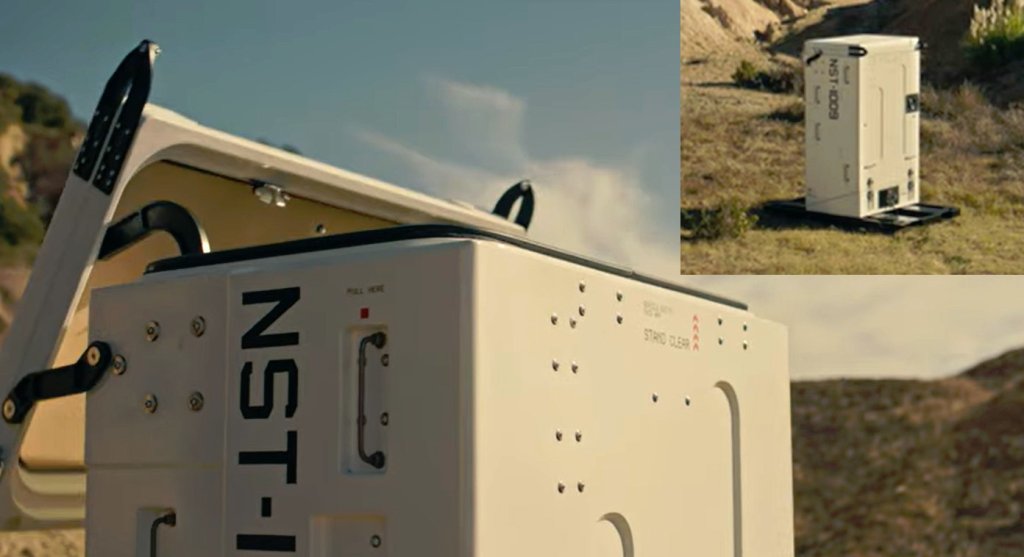
While costing less than typical effectors, such as SAMs, Coyote and Roadrunner also offer something these weapons don’t — the ability to loiter. This is a big deal as they can be dynamically tasked in real time and they can even be launched preemptively against potential threats. This offers a lot of flexibility for warship crews that don’t currently have such an option beyond employing the ship’s rotary-wing assets, if available. In the case of Roadrunner-M, it can be recovered and quickly used again. There is also the potential that these systems could be used to hit small surface targets, as well.
The threats posed by uncrewed aerial systems to Navy ships, as well as U.S. military assets and critical civilian infrastructure on land, even far from traditional battlefields, are not new, as TWZ has long highlighted. Those dangers are only set to grow in scale and scope, thanks in large part to advances in artificial intelligence and machine learning, and to keep proliferating among state and non-state actors.
That the Navy is only adding Coyote and Roadrunner-M to at least some Arleigh Burke class destroyers now highlights how the U.S. military continues to lag in addressing drone threats. TWZ also highlighted this in February 2024, when NAVSEA put out a broad call for potential new counter-drone capabilities that could be added to various Navy ships within 12 months, which may have contributed to the work being done now.
The Navy is also pursuing new directed energy weapons, electronic warfare suites, advanced networked decoys, and other tools to help further expand the air and missile defenses on its ships. Other interceptors could also be on the horizon, including using the multi-mode AGM-179 Joint Air-to-Ground Missile (JAGM) in the air-to-surface role. JAGM’s manufacturer, Lockheed Martin, has also been doing other work to demonstrate the missile’s abilities in the counter-drone role, whether launched from the air or the surface. The company notably showed a model earlier this year of an Areligh Burke class destroyer equipped with four-round launchers for JAGMs. The Navy’s Freedom class Littoral Combat Ships also just recently gained the ability to fire radar-guided AGM-114L Longbow Hellfire missiles, which are no longer in production and that JAGM looks set to supplant, at incoming drones.
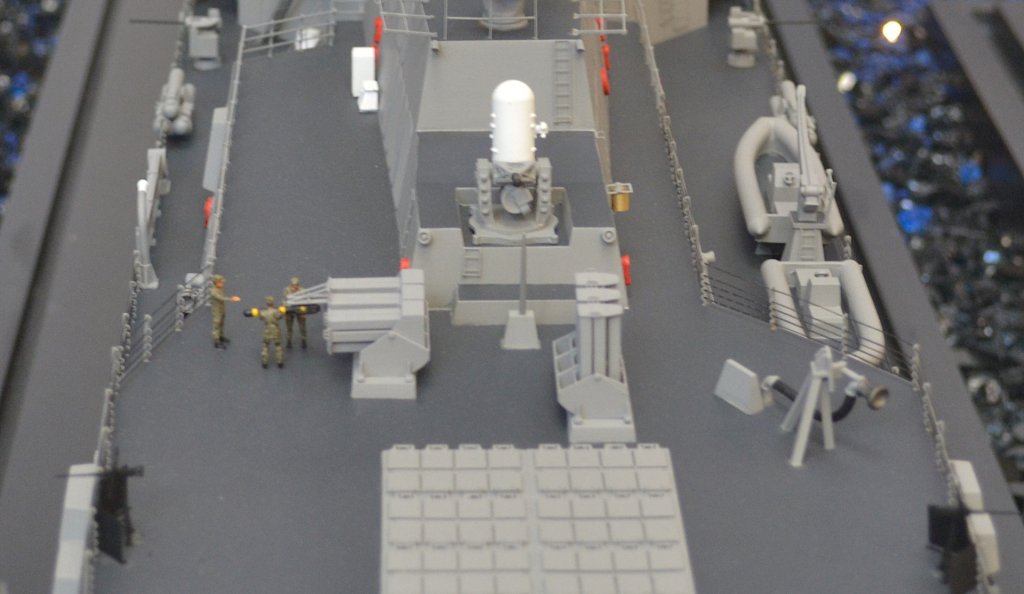
All this also ties into larger concerns about the adequacy of U.S. stockpiles of surface-to-air missiles and other key munitions and the ability to readily replenish them, especially in the event a large-scale conflict against China breaks out in the Pacific. Last year, the head of U.S. Indo-Pacific Command (INDOPACOM) explicitly warned that operations in and around the Red Sea, as well as ongoing support to Ukraine in its fight against Russia, were creating readiness risks in his part of the world.
At the same time, top service officials have stressed that captains and crews should not worry about taking whatever steps are necessary to defend their ships and the lives onboard, as well as other friendly forces.
“They have other things to worry about, like what’s for breakfast,” Vice Adm. Brendan McLane, head of Naval Surface Forces, told TWZ and other attendees at the annual Surface Navy Association conference in January. “The cost of the missile that they are going to shoot is not one of the things that they are worried about.”
Still, Coyotes and Roadrunners are now set to give at least some Arleigh Burke class destroyers important added defenses against incoming drones, and could be a step toward fielding those capabilities more broadly across the Navy’s fleets.
Contact the author: joe@twz.com
